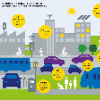Smart cities use technology to improve traffic patterns, energy distribution, air quality and more. The elements of a smart city can also increase the convenience for its citizens, by integrating IT technology into many aspects of citizen interaction such as simplifying access to many of the city services. The fields of healthcare, education, culture, and shopping can all be integrated into the core of a smart city to create an infrastructure that allows citizens to live more conveniently. Actual deployment cases exist in U.S., Europe, Singapore, and South Korea. With this environment, we need to think ahead about cybersecurity and prepare countermeasures as the cyberattacks in a smart city can threaten the lives of its citizens. In this paper, we examine smart city security threats from a multilayered perspective, targeting representative elements that make up a smart city. A summary of attack scenarios and threat countermeasures are also described.
翻译:智能城市利用技术改善交通模式、能源分配、空气质量等。智能城市的元素也可以通过将信息技术纳入公民互动的许多方面,例如简化获得许多城市服务的机会,增加公民的方便性。医疗、教育、文化和购物领域都可以纳入智能城市的核心,以创造使公民能够更方便地生活的基础设施。美国、欧洲、新加坡和南朝鲜存在实际部署案例。在这种情况下,我们需要先考虑网络安全,并准备对策,因为智能城市的网络攻击可能威胁公民的生命。本文从多层次的角度审视智能城市安全威胁,针对构成智能城市的代表性要素。还描述了攻击情景和威胁对策摘要。





